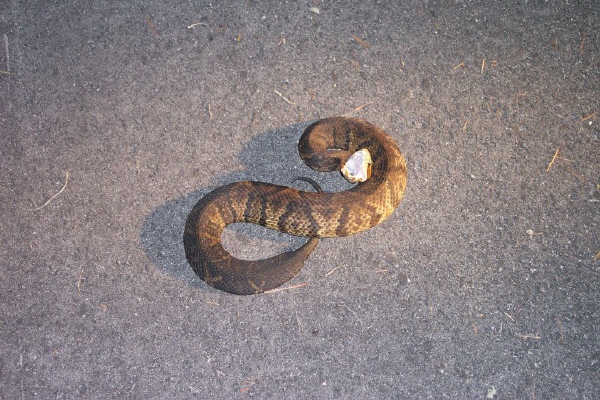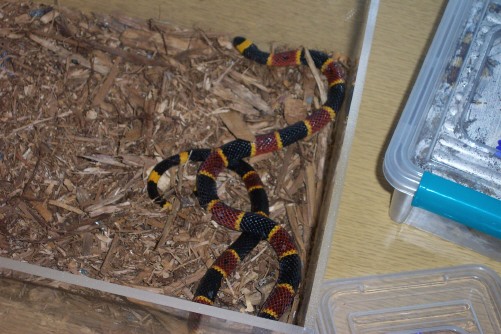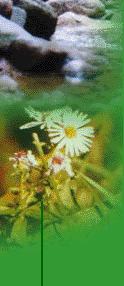|
All these snakes on this page are VENOMOUS!!! If you ever encounter one please leave it be and walk away.
They do not want to hurt people!!! Also all the snakes on this page live in Southeast.

|
| Found in Murray County, GA |
Copperhead (Agkistrodon contortrix)
The Copperhead is the
most common venomous snake in the Southeast. The copperhead is one of the few venomous snakes that have adapted very well
to urban life. They can be found even in big cities like Atlanta. It is not uncommon at all to find them in some
people back yards which border a woodland forest. They reach lengths up to and over four feet and the maximum record is 53in.
The copperhead mostly feed off small rodents, frogs, birds, lizards, and even large insects. The copperhead can be found in
almost any terrestrial habitats including rocky outcrops which are mostly found in the mountains, the can be found near a
creek or river, on the margins of swamp. The copperhead can most be easily be identified by the hourglass-shaped crossbands
on the back of the snake. No other snakes found in Georgia
have this pattern. The babies can easily be identified a sulfur-colored tail. During the spring and fall they are mostly found
during the daylight hours. During the hot summer months the copperhead becomes almost strictly nocturnal (comes out at night).
In my experience they are most active in the fall during the second of two mating seasons. When threaten they will puff up
to make themselves look bigger, rattle their tail, and will release a strong musk from their cloacae.

|
| Found in Charlton County, Ga |
Cottonmouth/Water Moccasin (Agkistrodon pisvivorus)
The Cottonmouth/Water Moccasin is probably one
of the most notorious snakes of the south. There are many legends about this snake. The snake has two names and cottonmouth
is the most appropriate one, and this name is given because when it is threatened it will open its mouth and the lining of
the mouth is cotton white. The cottonmouth is a large snake which has been reported to reach 6 feet 2 inches. This snake lives
mostly in old cypress and tupelo swamps of the Deep South but they will live in almost anyplace which is located near water. They also
live in marshlands, secluded river systems and several other sources of water. They are a very opportunistic feeder. Their
diet will include frogs, fish, small mammals, baby alligators, baby turtles, salamanders, and other snakes. They are also
known to eat dead animals on the road. Like the copperhead a baby cottonmouth has a sulfur yellow tail and also looks very
similar in appearance. During the spring and fall they become somewhat diurnal (comes out in day) but you still may see them
at night. During the summer they will become almost exclusively nocturnal and will sometimes be seen in the day coiled up
in some cypress or tupelo roots. They are very secretive snakes and most of the time does not come in contact with people
that often. This snake gets confused with most water snakes. When threatened water snakes will puff up and almost completely
looks like a cottonmouth. One way to tell if the snake is a cottonmouth is when it swims they will swim with almost their
whole body out of the water, but the water snake swim mostly underwater. There is big misconception that the snakes you see
in brush over hanging a creek, river, pond, lake, and other bodies of water are cottonmouths. Almost always it is a water
snake and there is story of them falling into the boat and biting people. One other thing is that water snakes are very quick
to learn of danger and will slide in the water immediately, but the moccasin is very slow to become aware of danger. If confronted
most moccasins if they are not sure they can escape will stand their ground which gives people a big misconception that they
are aggressive. There is a great misconception that moccasins are north of Atlanta.
Lake Lanier and Lake Allatoona do not have cottonmouths but
people still swear that there are cottonmouths there.

|
| Found in Okeechobee County, FL |
Eastern Diamondback Rattlesnake (Crotalus adamanteus)
The Eastern Diamondback Rattlesnake
in the largest and most dangerous venomous snake in the country. The Eastern Diamondback has been a recorded to be over 8 feet long. This snake has become scarcer
in the past 20 years. The hunting for these snakes still goes out through the southeast. The rattlesnake roundup is when they
go out and catch as many rattlesnakes as possible, and then they will chop their heads in the end. The snake is very secretive
and on only a occasion does this snake will come across people in the southern counties of this state. This snake lives in
several habitats including the longleaf pine/saw palmetto habitat, sandhill habitats, and coastal islands with comparable
habitat. This snake can often be found near a gopher tortoise colony since they use the tortoise’s burrow for cover
and hibernation. This snake is mostly crepuscular (comes out at dawn and dusk). The reason for this is that its favorite food
source which is rabbits comes out at this time too. They will also eat squirrels, cotton rats, voles, and cotton mice. This
snake needs the utmost respect if ever encountered in the wild. The Eastern Diamondback Rattlesnake has been known to have
killed people, and if you encountered one you should treat it with the most utmost respect and leave it be.

|
| Found in Charlton County, Ga |
Canebrake Rattlesnake (Crotalus horridus atricaudatus)
The Timber/Canebrake Rattlesnake
has the second largest distribution of any venomous snakes other than the copperhead. This rattlesnake is divided up to two
subspecies which are the Timber and the Canebrake. The timber rattlesnake has a lot darker pattern without the orange stripe
down the back. While the canebrake is a lot lighter with an orange to rust color stripe on its back. The two color patterns
of the timber are the yellow phase and the black phase. The timber rattlesnake is found mostly in the mountains of the northern
states in this country. This snake is smaller than its cousin while it mostly only reaching 4 feet while the canebrake can
easily reach over 5 feet. The record on both snakes was 6 feet 2 inches. The timber rattlesnake is found mostly in rocky outcrops
on tops of mountains also will live in hardwood forest. The canebrake mostly prefers the costal plains of this region and
also will live in many different habitats including areas that border swamps, longleaf pine/saw palm habitat, rocky outcrops
at the northern most part of its range, and hardwood forest. Both subspecies
mostly feed on small mammals such as shrews, mice, rats, squirrels, chipmunks, rabbits, and also will occasional feed on birds.
Sadly the timber rattlesnake in the Northern states is considered threatened or endangered. Several states in the Northeast
are now extinct of this wonderful snake. One big thing that leads to their decline is that most Timber rattlesnakes hibernate
in huge dens with hundreds if not thousands of snakes. The snakes from both subspecies during spring and fall are Diurnal
(comes out during the day) while during the hot months of summer they will become Nocturnal (comes out at night).

|
| Location Unknown |
Coral Snake (Micrurus fulvius
Description COMING SOON!!

|
| Found in Clinch County, Ga |
Dusky Pigmy Rattlesnake (Sistrurus miliarius barbouri)
Description COMING SOON!!
|









